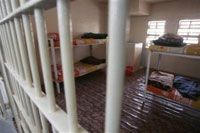Abu Ghraib reopens in Iraq under new name to 'welcome' thousands of inmates
Iraq’s infamous Abu Ghraib prison, which became world-known after a series of pictures of US servicemen torturing Iraqi prisoners, has been put into operation again. The prison will now work under a new name. Deputy Justice Minister Bushu Dazai said that the Central Prison of Baghdad was working again.

The prison will allow to release the tension of the overpopulation of the nation’s prisons: it has already “welcomed” 400 people from other detention centers. Over 3,000 other prisoners will be transferred to the renovated prison by the end of the month. The prison will be able to accommodate between 12-15 thousand inmates in total.
Abu Ghraib, the largest prison in Iraq, located 25 kilometers far from Baghdad, was built during the 1960s on 1,000 hectares of land. The prison became the symbol of Saddam Hussein’s crimes against his people – over 4,000 adversaries of his political regime were supposedly tortured and executed there.
The image of the prison changed drastically in the beginning of 2004 when it was revealed that US servicemen in Abu Ghraib were torturing and humiliating Iraqi inmates. The prison was passed to the Iraqi authorities in 2006 and subsequently closed. The government of the country originally intended to convert the prison to a warehouse, but the plans changed.
Baghdad’s Central Prison is now equipped with a gym, a computer class, a medical room and even a children’s playground with a fountain where inmates will meet their relatives.
Beginning in 2004, accounts of abuse, torture, sodomy and homicide of prisoners held in the Abu Ghraib prison in Iraq (also known as Baghdad Correctional Facility) came to public attention. These acts were committed by personnel of the 372nd Military Police Company of the United States Army together with additional US governmental agencies. These additional agencies have been referred to as the OGA (Other Government Agencies), which is an often-used euphemism for the Central Intelligence Agency.
As revealed by the 2004 Taguba Report, a criminal investigation by the US Army Criminal Investigation Command had already been underway since 2003 where many soldiers of the 320th Military Police Battalion had been charged under the Uniform Code of Military Justice with prisoner abuse. In 2004 articles describing the abuse, including pictures showing military personnel abusing prisoners, came to public attention, when a 60 Minutes II news report (April 28) and an article by Seymour M. Hersh in The New Yorker magazine (posted online on April 30 and published days later in the May 10 issue) reported the story. Janis Karpinski, the commander of Abu Ghraib, demoted for her lack of oversight regarding the abuse, estimated later that 90% of detainees in the prison were innocent.
The United States Department of Defense removed seventeen soldiers and officers from duty, and seven soldiers were charged with dereliction of duty, maltreatment, aggravated assault and battery. Between May 2004 and September 2005, seven soldiers were convicted in courts martial, sentenced to federal prison, and dishonorably discharged from service. Two soldiers, Specialist Charles Graner, and his former fiancée, Specialist Lynndie England, were sentenced to ten years and three years in prison, respectively, in trials ending on January 14, 2005 and September 26, 2005. The commanding officer at the prison, Brigadier General Janis Karpinski, was demoted to the rank of Colonel on May 5, 2005. Col. Karpinski has denied knowledge of the abuses, claiming that the interrogations were authorized by her superiors and performed by subcontractors, and that she was not even allowed entry into the interrogation rooms.
The abuse of detainees at Abu Ghraib was in part the reason that on April 12, 2006, the United States Army activated the 201st Military Intelligence Battalion, the first of four joint interrogation battalions.
Source: agencies
Subscribe to Pravda.Ru Telegram channel, Facebook, RSS!





